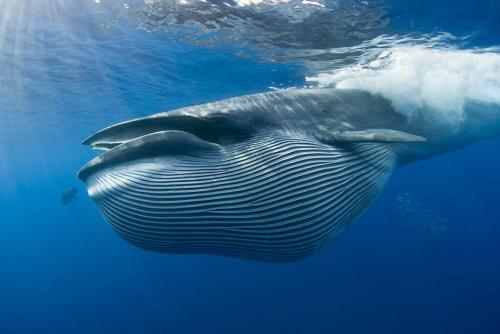(单词翻译:单击)
听力文本
This is Scientific American — 60-Second Science. I'm Jason G. Goldman.
Baleen whales feed by opening their gigantic maws, lunging forward in the water and engulfing gallons of seawater in their mouths. They strain the seawater back through their baleen plates, trapping vast numbers of tiny critters—fish, krill and others—that then get swallowed all at once. The species that share this method include what are called the rorqual whales, which include fin whales, sei whales, blue whales and humpback whales.
But now a team of Japanese and Thai researchers has discovered a never-before-seen type of feeding behavior in a rorqual called a Bryde's whale. These whales don't bother with the lunge. They simply open their mouths at the surface and let the seawater flow in, before straining and expelling the seawater through their baleen as usual.
The researchers call it tread-water feeding because of the way the whales gently undulate their tails to keep their heads near the surface of the water. They say it's the first passive feeding strategy ever seen in a baleen whale. The team, led by Takashi Iwata from the University of Tokyo, observed 31 different whales feed this way in the Gulf of Thailand.

Tread-water feeding is more energy-efficient than lunge-feeding, since the whales just have to bob their heads near the surface. But Iwata thinks that the odd behavior may have a darker origin.
The upper Gulf of Thailand is hypoxic—there's a serious lack of oxygen dissolved in the water, thanks mostly to sewage that flows into the sea from nearby rivers. The low oxygen levels might force the whales' prey towards the surface, where oxygen is a bit more plentiful. And if all the food is in one spot, then tread-water feeding might be the only way to get enough nutrition. Which means that these whales apparently improvised an improved strategy for survival in their polluted habitat.
Iwata wrote in an e-mail that his team witnessed tread-water feeding most often in adult-calf pairs. That observation leads him to suspect that the behavior might be socially learned, passed from parents to their offspring via imitation.
If that's true, then tread-water feeding could represent a form of culture, unique to the Bryde's whales that live in the Gulf of Thailand.
Thanks for listening for Scientific American — 60-Second Science. I'm Jason G. Goldman.
参考译文
这里是科学美国人——60秒科学。我是杰森·古德曼。
须鲸的进食方法是:张开大嘴在水里向前猛冲,将大量海水吞入口中。须鲸用须鲸板把海水过滤出去,把大量鱼、磷虾及其它微小生物留在口中,然后一并吞下。像鳍鲸、鳁鲸、蓝鲸和座头鲸等须鲸科物种,均用这种方法进食。
但现在一个由日本和泰国的研究人员所组成的团队发现,一种名为布氏鲸的须鲸有一种前所未见的摄食行为。这些鲸鱼不用费力在水中猛冲。它们只是简单地在海面上张开嘴,让海水流进口中,然后照样用须鲸板过滤并排出海水。
研究人员称这种进食方法为“踩水进食法”,因为布氏鲸会轻轻地甩尾巴,来让头部靠近水面。研究人员表示,在他们目前观察到的须鲸行为中,这是第一例被动进食策略。这一团队由来自东京大学的岩田孝领导,他们在泰国湾对采取这种进食方式的31种鲸鱼进行了观察。
“踩水进食法”比“猛冲进食法”的效率更高,因为鲸鱼只需让头部在水面附近摆动就行。但岩田孝认为这种奇怪行为的缘由可能较为阴暗。
泰国湾上游缺氧——溶解在水中的氧气严重匮乏,这主要是由于污水从附近的河流涌入大海所造成的。低氧水平可能迫使鲸鱼的猎物升至海面,因为海面的含氧量更为充足。如果所有食物都集中在海面上,那“踩水进食法”可能是鲸获取足够养分的唯一方式。这意味着,在被污染的栖息地,看起来这些鲸鱼即兴创造了这种改革策略来维持生存。
岩田孝在电子邮件中说,他的团队发现采用“踩水进食法”的多为成年鲸鱼和幼崽。这一观察结果使他怀疑这种行为可能是通过社交习得的,子女通过模仿父母的行为而获得。
如若属实,那“踩水进食法”可能代表了一种文化形式,一种生活在泰国湾的布氏鲸独有的文化形式。
谢谢大家收听科学美国人——60秒科学。我是杰森·古德曼。
译文为可可英语翻译,未经授权请勿转载!
重点讲解
重点讲解:
1. all at once 同时;一起;
例句:A number of things happened all at once.
几件事一起发生了。
2. as usual 像平常一样;照例;
例句:She was getting breakfast as usual.
她像往常一样在准备早餐。
3. thanks to 幸亏;归因于;
例句:They were already under stress, thanks to the aftershock of last year's drought.
去年遭受的旱灾让他们心有余悸、倍感忧虑。
4. lead sb. to do sth. 促使;使得;使;
例句:His actions lead me to distrust him.
他的行为使我不信任他。


